

Below are some pictures presenting MERLIN and/or VLBI results. We would love to include your work too. If you have any MERLIN or VLBI science pictures please email them to (merlin@jb.man.ac.uk) so they can also be included.
If you choose to use any of these images please credit the appropriate scientific articles and contact merlin@jb.man.ac.uk.
Please click on images for full resolution.
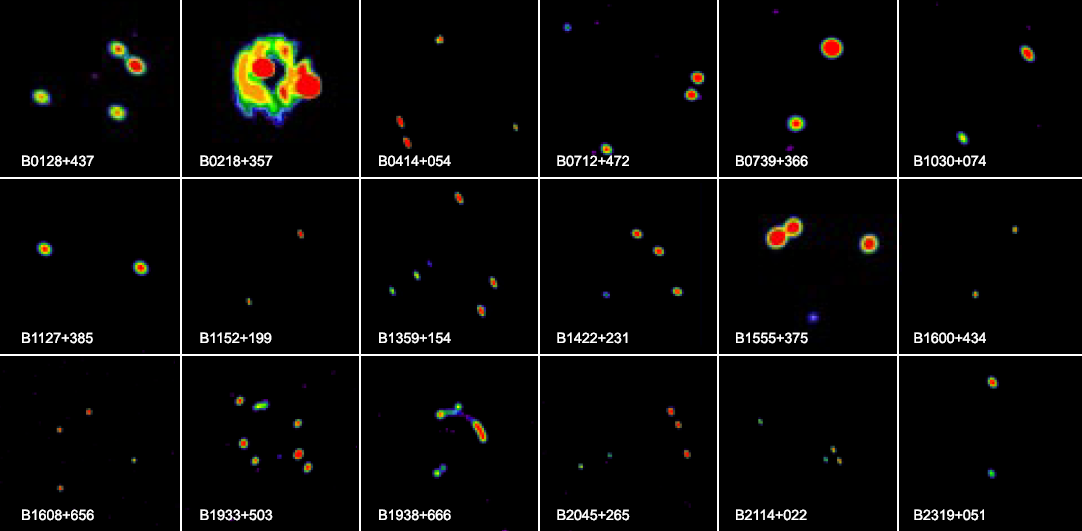 |
MERLIN/VLA images of 18
new gravitational lenses from the
JVAS/CLASS survey.
|
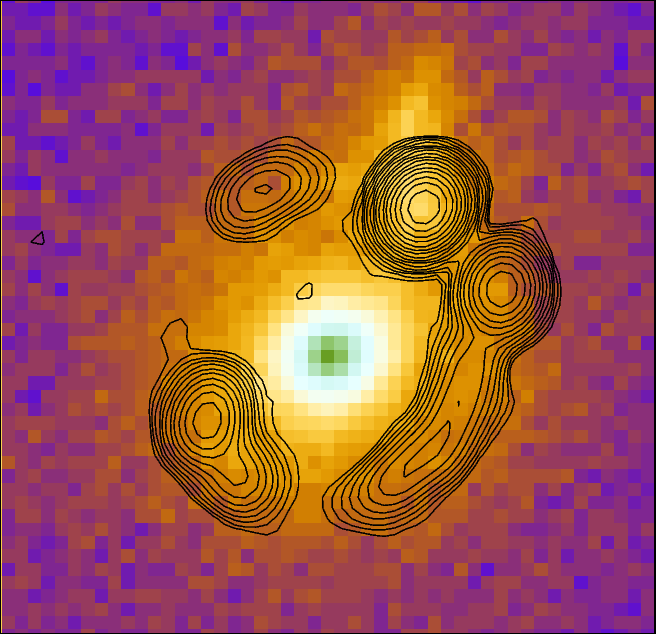 |
MERLIN 1.7 GHz image (contours) of the gravitational
lens system CLASS 0631+519, overlaid on the HST I-band
image (colour). The HST image shows the two galaxies in the
lensing system, and the MERLIN image reveals a large amount
of detail that can be used to make mass models of the lens.
|
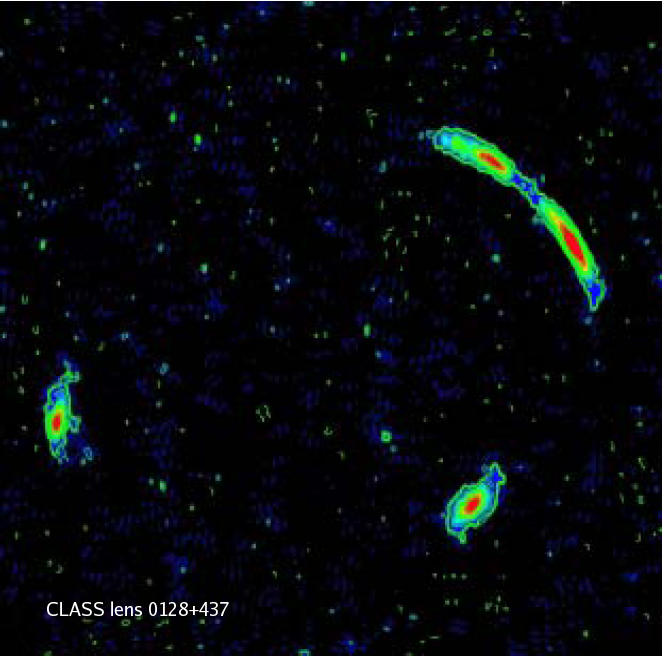 |
CLASS 0128+437 is one of the most interesting gravitational lens systems found during the CLASS survey. Model
fitting to the 1.4 GHz EVN image has proved difficult, which strongly suggests the presence of substructure in the
mass distribution of the lensing galaxy.
|
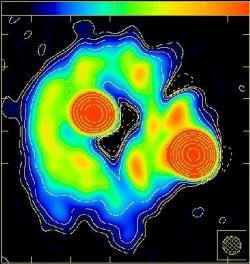 |
The gravitational lens CLASS B0218+357.
|
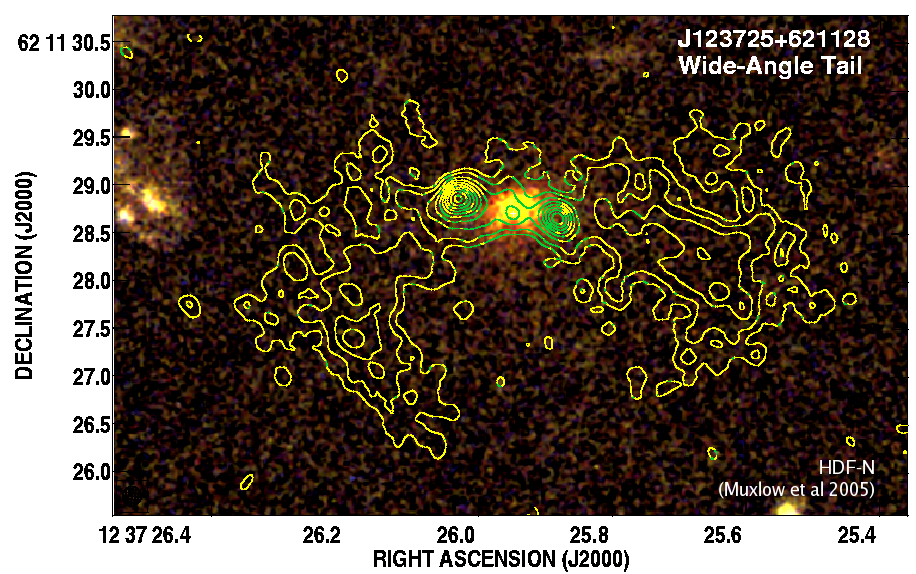 |
Faint wide angle-tailed radio galaxy with the Flanking fields of the
Hubble Deep Field North. Contours show the
deep MERLIN+VLA 1.4GHz radio continuum
overlaid onto a 'pseudo-real' colour
(BViz) HST ACS image.
|
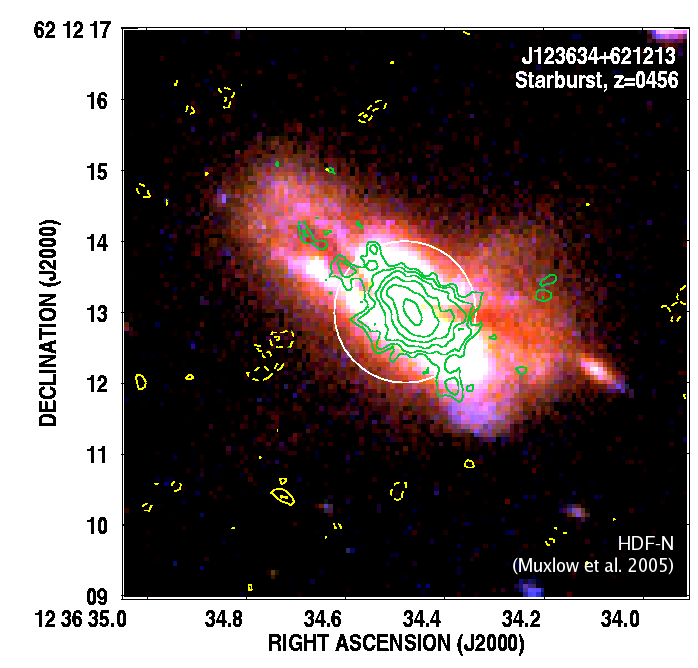 |
Distant starburst galaxy within
Hubble Deep Field North. Contours show the
deep MERLIN+VLA 1.4GHz radio continuum
overlaid onto a 'pseudo-real' colour
(BViz) HST ACS image.
|
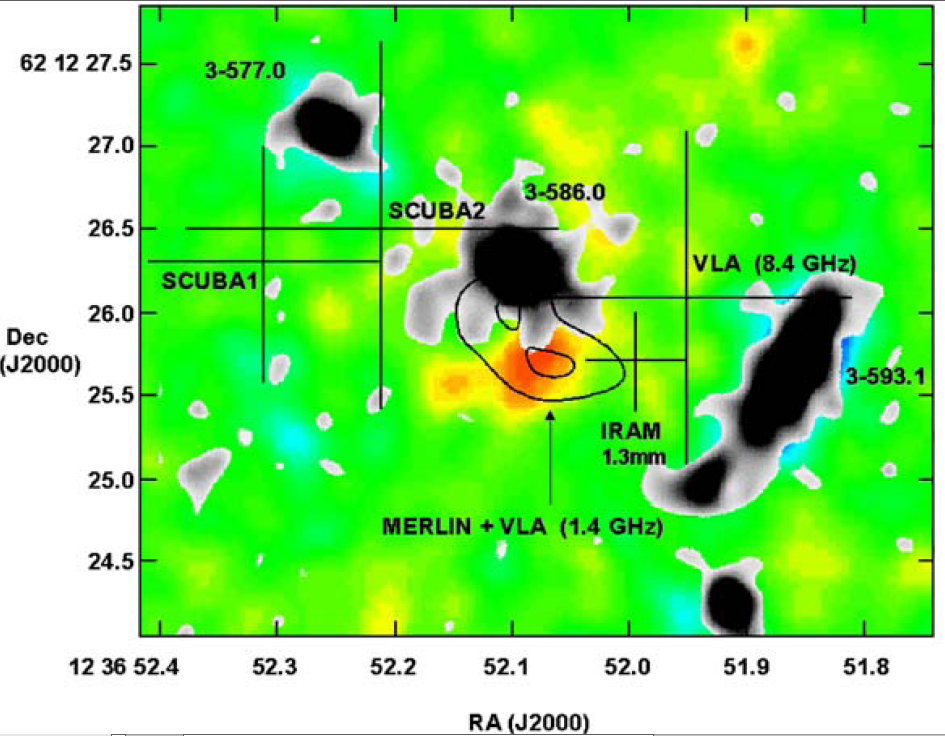 |
MERLIN+VLA image
(contoured) showing the 16 microJy
radio source associated with
SCUBA 850.1. The original and
revised SCUBA positions (SCUBA 1
and 2) are also marked together
with the IRAM position and a VLA
8.4 GHz detection. A residual
Subaru K band image (false colour)
shows the identification to be a
very red object lying 0.8
arcseconds to the SSE of elliptical
galaxy 3-586.0.
|
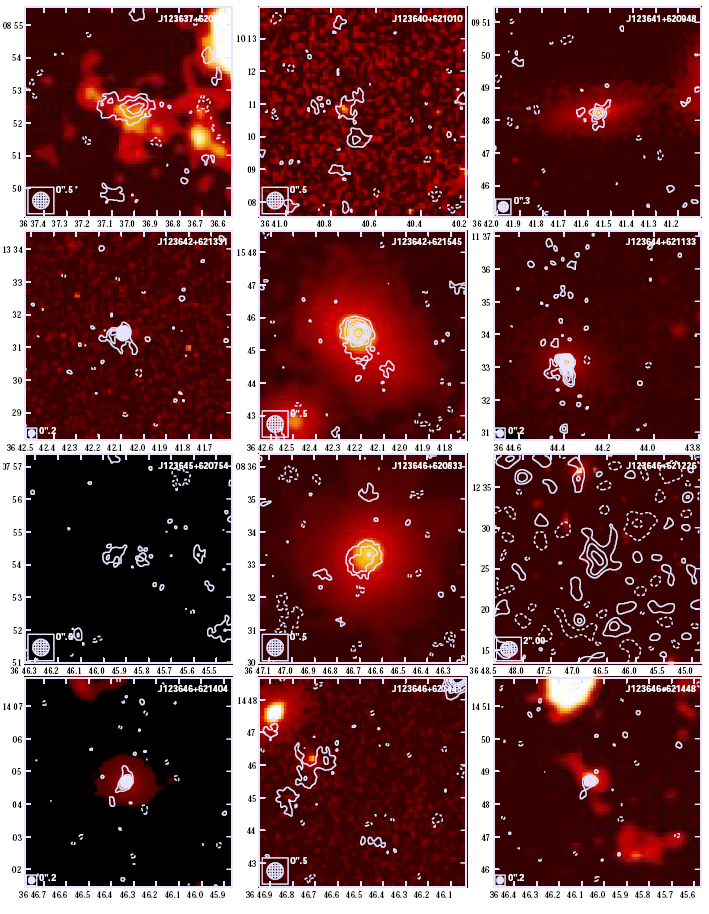 |
MERLIN+VLA radio contours
superimposed on the HDF/HFF for
12 of the 92 detected radio sources in the HDF and HFF
|
 |
Deep MERLIN + VLA 5GHz image of the nearby starburst galaxy M82.
|
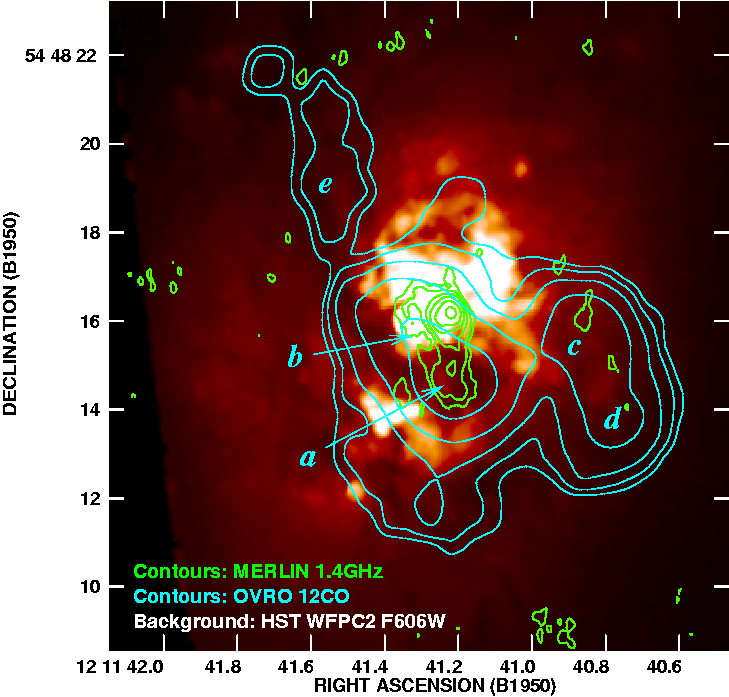 |
Composit image showing the 1.4GHz MERLIN radio continuum structure
(green), Carbon Monoxide Gas (blue)
and optical structure (false colour)
of the centre of the nearby
starforming galaxy merging galaxy
NGC4194, otherwise known as the Medusa
Merger.
|
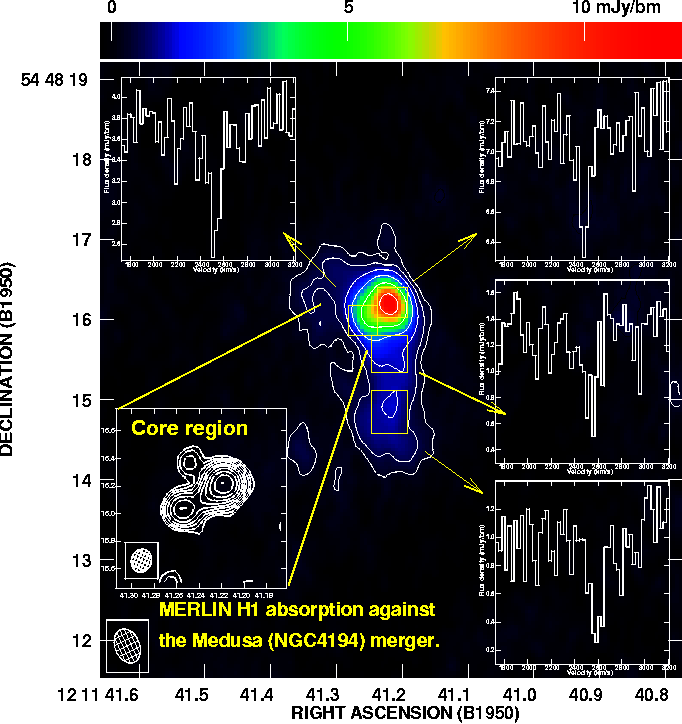 |
1.4GHz MERLIN radio continuum of, and associated HI absorption
spectra against, the centre of the nearby
starforming galaxy merging galaxy
NGC4194, otherwise known as the Medusa
Merger.
|
 |
MERLIN radio continuum image at 1.4GHz (left) and neutral gas (H1)
velocity field from the
centre of the gas-rich merger Arp193.
|
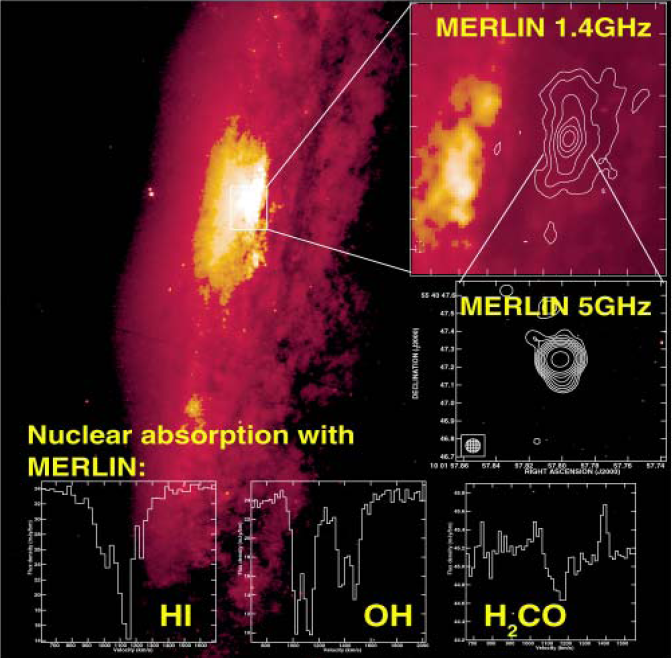 |
Composite image showing the broadband HST optical image of nearby the
Seyfert/LINER galaxy NGC
3079 along with inset high
resolution radio continuum
images. Neutral and
molecular gas absorption
spectra observed, with
MERLIN, against the nucleus
are also inset.
|
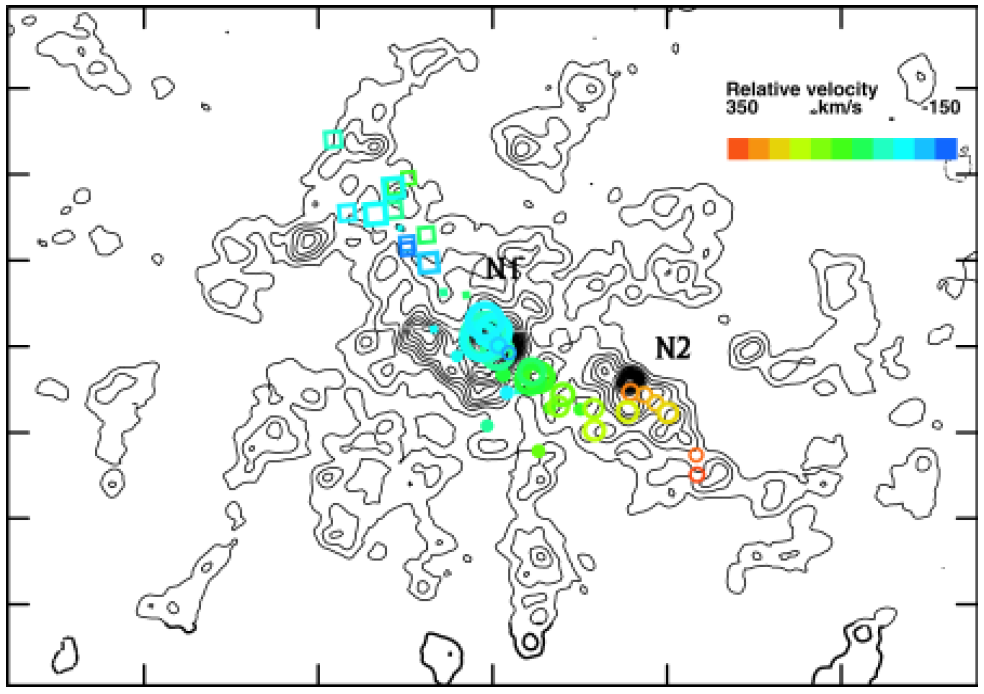 |
MERLIN+EVN image of the northern component of Mrk 273 at 5 GHz. Overlain are the 1.6 GHz maser
components colour-coded for velocity.
|
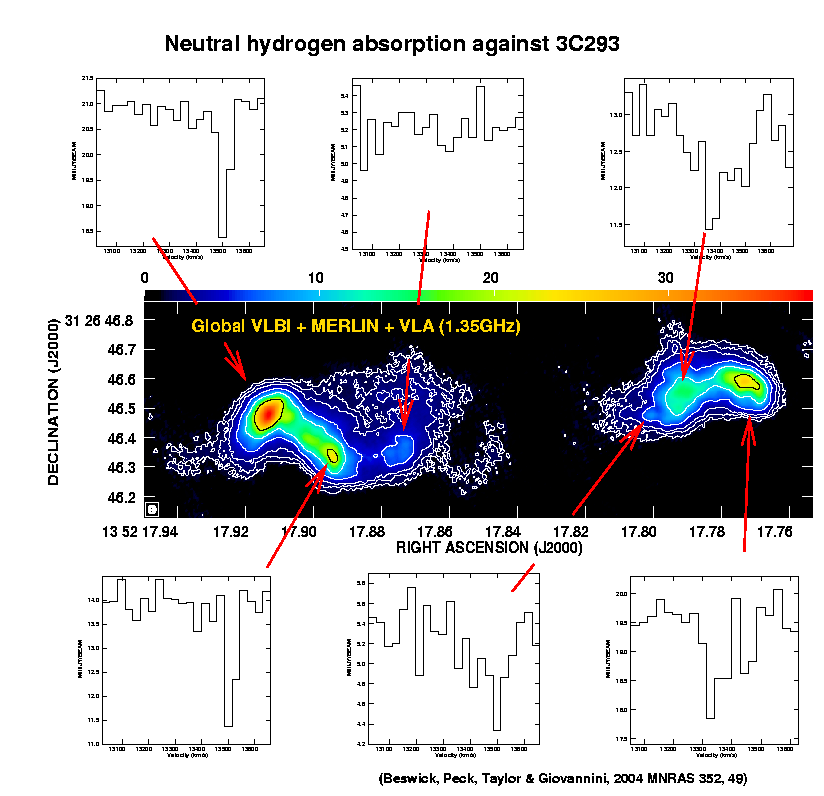 |
High resolution combined Global VLBI + MERLIN + VLA (inc. Pie Town)
1.35GHz radio continnum
image of the nearby
radio galaxy 3C293,
along with selected HI
absorption spectra.
|
 |
Four images showing the jets in the nearby radio galaxy 3C293. Top
right: 1.35GHz MERLIN
radio image with a 0.2
arcsec resolution. Top
left: 1.35GHz Global
VLBI + MERLIN + VLA
(inc Pie Town) radio
image with a 30mas
angular resolution
(inner part of Top
right image
only). Bottom left
5GHZ Multi-frequency
synthesis MERLIN image
with a 50mas angulare
resolution. Bottom
right: False colour
MERLIN 5GHz image
overlaid with NIR HST
image as
contours. Note the
brightest radio knots
are also traced by the
NIR contours.
|
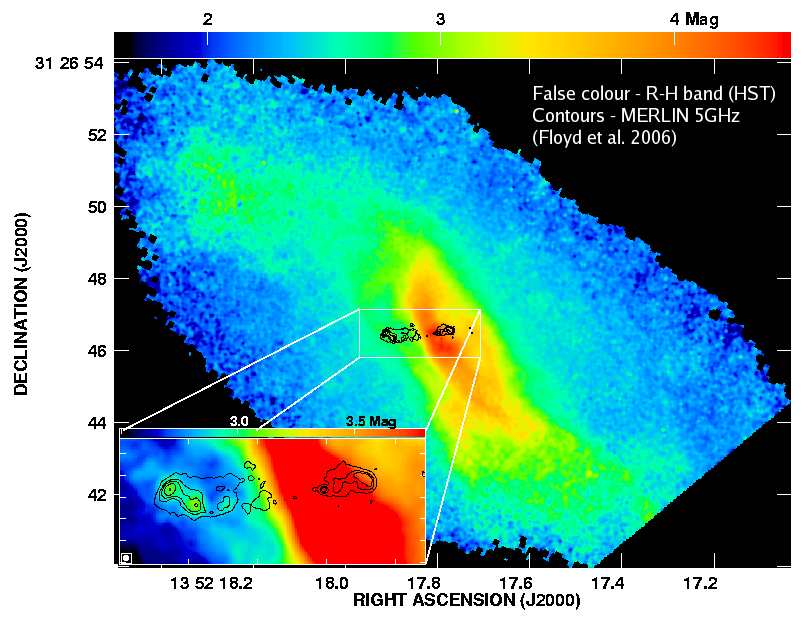 |
The radio galaxy 3C293: |
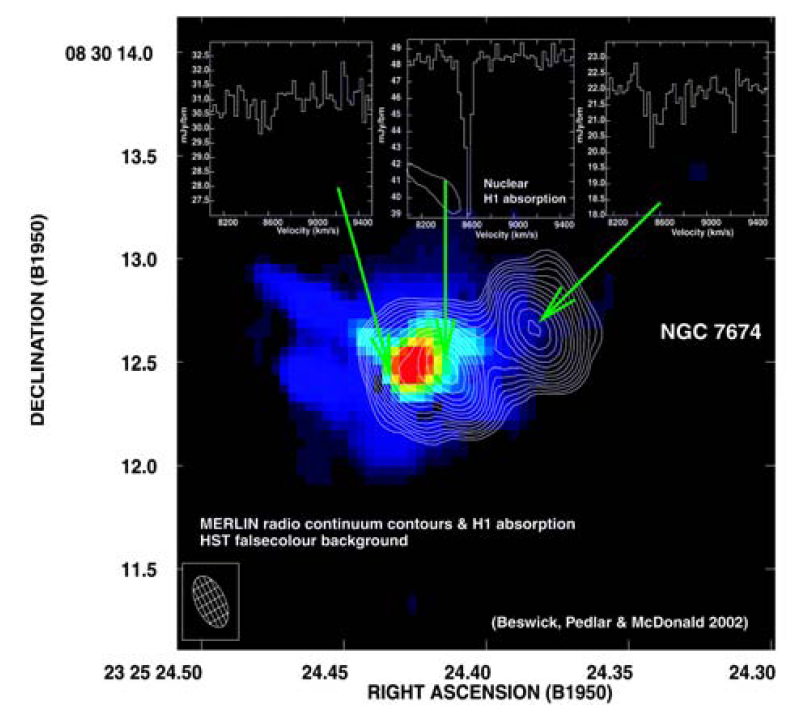 |
The sub-arcsecond
MERLIN 21 cm nuclear structure
of the Seyfert 2 galaxy NGC 7674,
shown as contours overlaid on a
false-colour HST WGPC-2 optical image. The
higly localised absorption against
the AGN is evident in the inset
spectra.
|
 |
MERLIN 21 cm radio
continuum structure of the
nuclear region of the Seyfert 1
galaxy NGC 7469 overlaid on a
false-colour HST WFPC-2 image.
Both the radio and optical images
show the bright nucleus and
diffuse emission from a
circumnuclear starburst. The inset
spectra show deep nuclear HI
absorption detected with MERLIN.
|
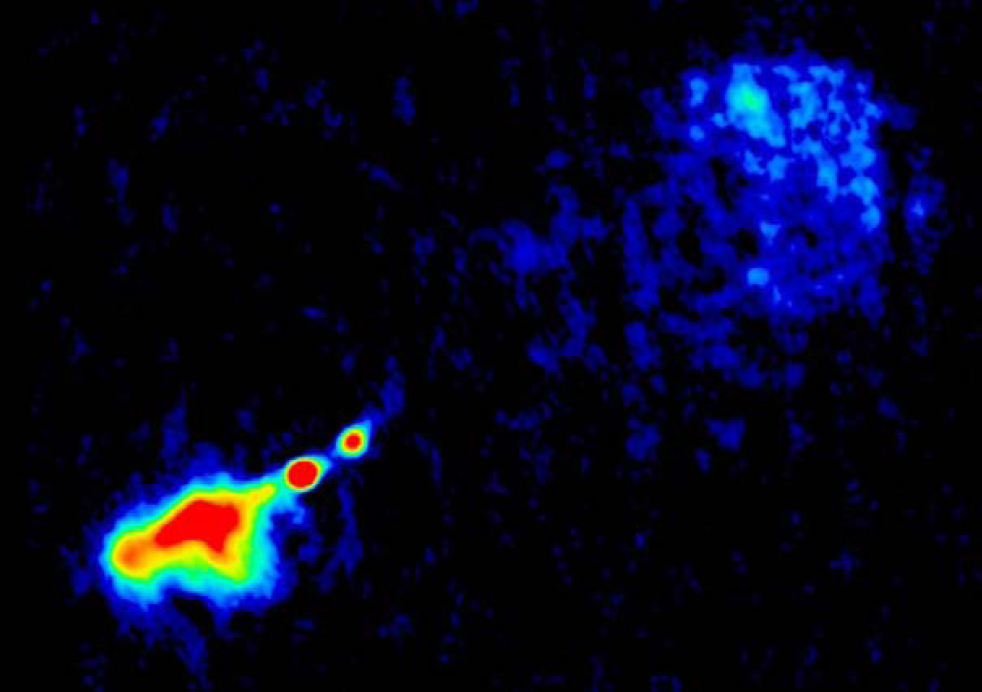 |
A 1.6 GHz image of the giant
radio galaxy 3C 236. With a linear
extent of ~4 Mpc, this is the largest
known raio source in the universe,
although this image shows only in
the inner part (~2 kpc) of the
source.
|
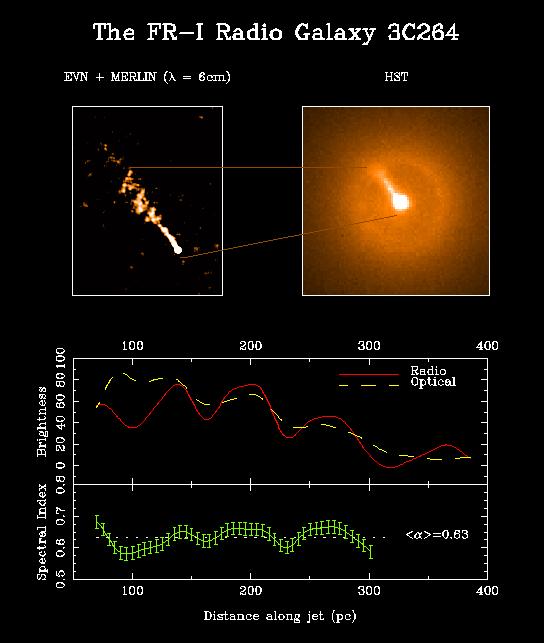 |
EVN+MERLIN 6-cm and Comparison HST Observations of 3C264. These observations reveal a change in the jet morphology that is coincident with an optical "ring" that has been imaged with the Hubble Space Telescope (HST).
|
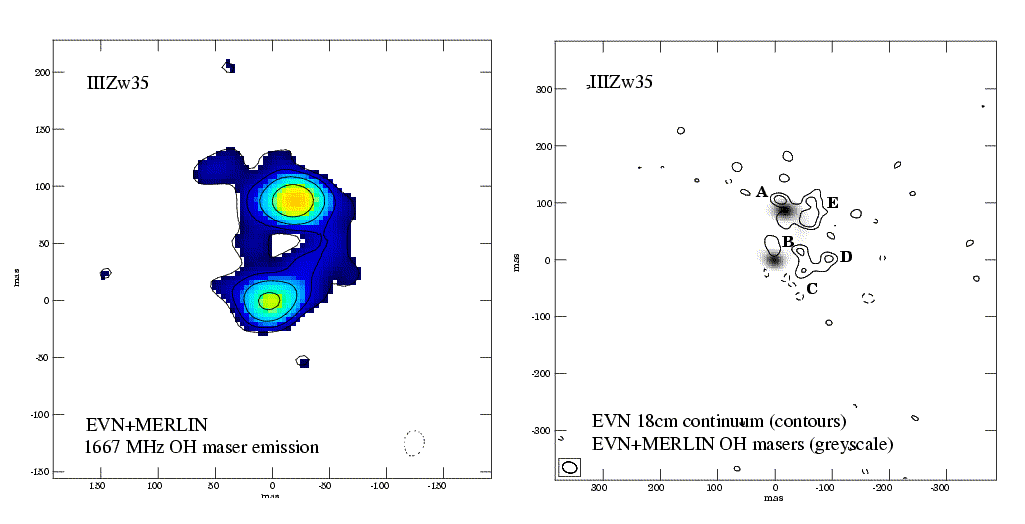 |
EVN+MERLIN 18cm observations of the luminous infrared galaxy IIIZw35
show the OH megamaser emission to have a ring-like distribution. Such a ring can account for both the compact as well as the diffuse masers observed. The same observations also show compact continuum sources that are consistent with being either radio supernovae or supernova remnants.
|
 |
False-colour images of 4 epochs, between 1986 and 2001, of VLBI
observations of the RSNe 43.31+575 in M82. All images have been
convolved with a circular 15mas beam in order to match the
earliest 1986 EVN-only epoch. The crosses marked on epoch 4
represent the positions of the three compact knots observed in
epoch 1.
|
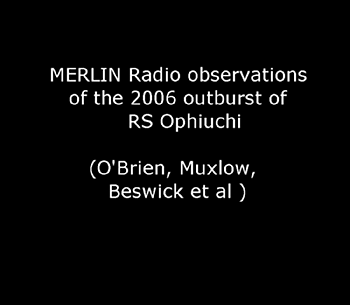 |
Movie showing the radio evolution at 6.034GHz of the recurrent Nova RS
Ophiuchi during the first 107 days of its February 2006 outburst as observed with MERLIN.
|
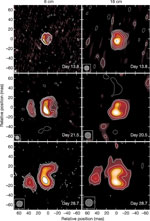 |
Using the VLBA and the EVN the radio emission from the expanding
shock-wave in the 2006 outburst of the recurrent Nova RS Ophiuchi has been imaged. The six images show the evolution of the radio structure of the shock wave from 14 days after the outburst to 29 days after outburst at 6 and 18cm. The top and bottom panels are taken from VLBA observations and middle panel from EVN observations.
|
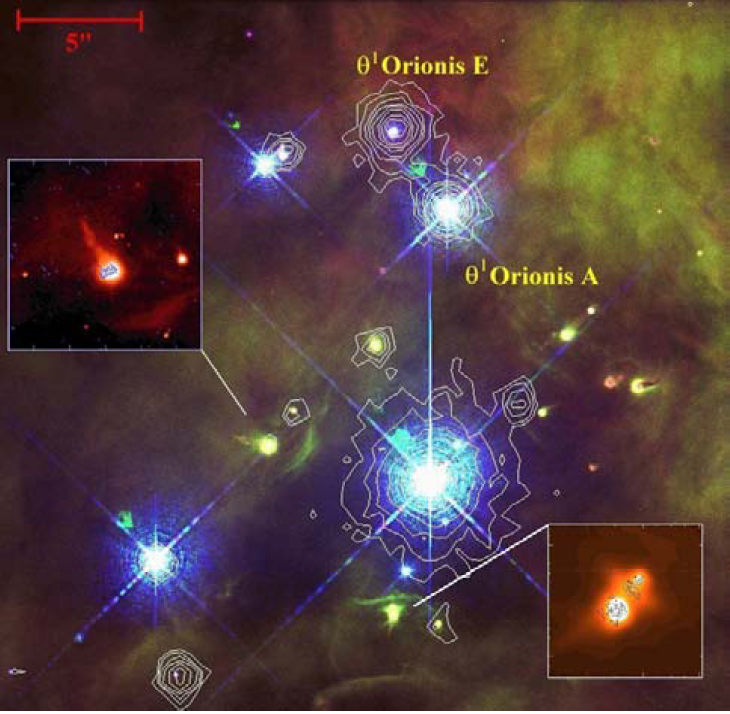 |
An HST optical image of the
Trapezium Cluster with Chandra Xray
contours overlaid. The inserts
show two of the HST Hydrogen alpha images of
proplyds within the cluster with
MERLIN 5 GHz contours overlaid.
|
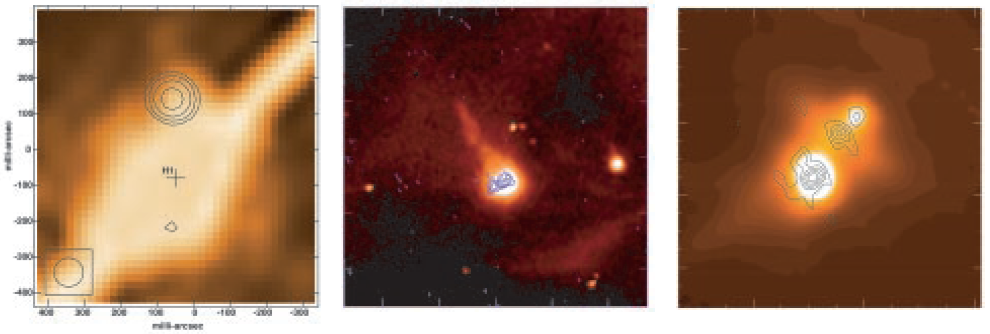 |
(left) MERLIN contours
overlaid on an overexposed HST
image of q1 Orionis A. The radio
source is displaced 220mas from
the Hipparcos position (H1).
(centre) MERLIN 5GHz contours
overlaid on an HST Ha frame of the
proplyd LV2. (right) MERLIN
contours of the proplyd LV1.
|
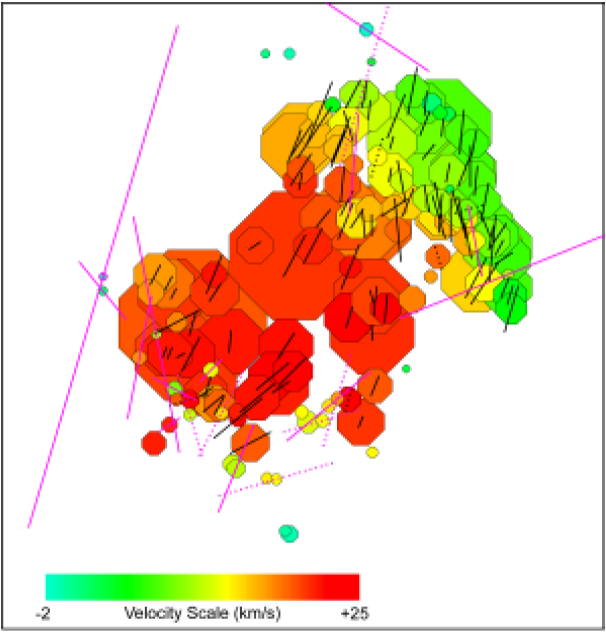 |
OH maser emission around NML Cyg with the
polarization vectors shown in pink for the `old' shell and in
black for the new more collimated wind.
|
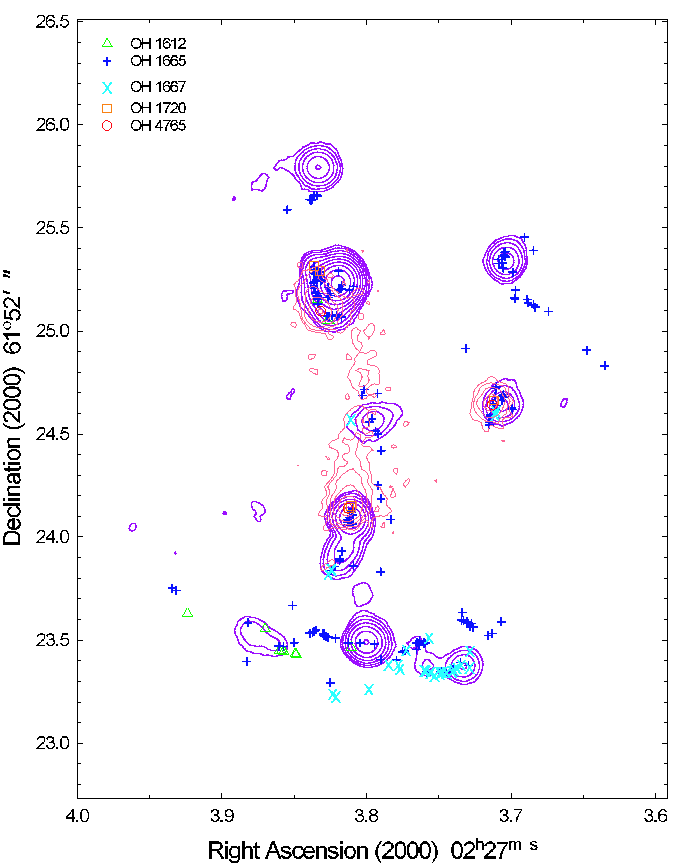 |
W3(OH) methanol masers along the zone of
interaction around a pre-main-sequence star. The excited OH
elongated filament (red) is overlain with the positions of
ground state masers (symbols) and methanol filaments (purple).
|
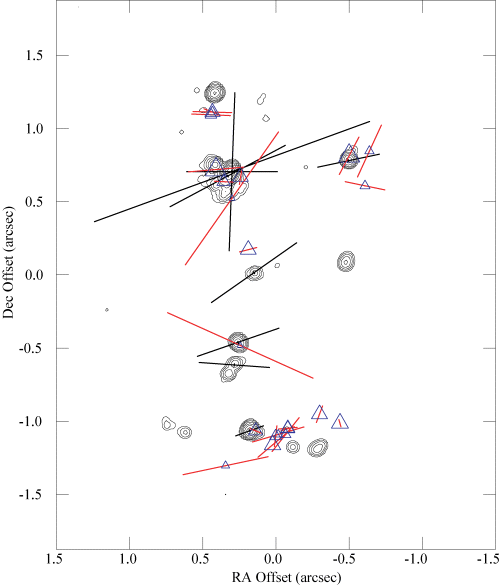 |
The first 6.7 methanol maser polarisation map. The polarisation vectors indicate a magnetic field along the extended N-S maser structure.
The methanol masers of W3(OH) (contours) including the
polarisation vectors (black) scaled linearly according the fractional linear
polarisation (PL). The blue triangles denote the main line OH masers from Wright
et al. (2004b) for which polarised intensity was detected at 5sigma significance
(polarised flux >7 mJy), and the red vectors are their linearly scaled
polarisation vectors. The main line OH maser polarisation vectors lengths are
scaled down by a factor of 5 with respect to the lengths of the methanol maser
polarisation vectors.
|
 |
MERLIN observations of
V778 Cyg. The overall structure of
H2O maser emission can be seen
in the map. The plot of velociy
components versus the distance
along the major axis clearly
confirms the presence of the disc.
|
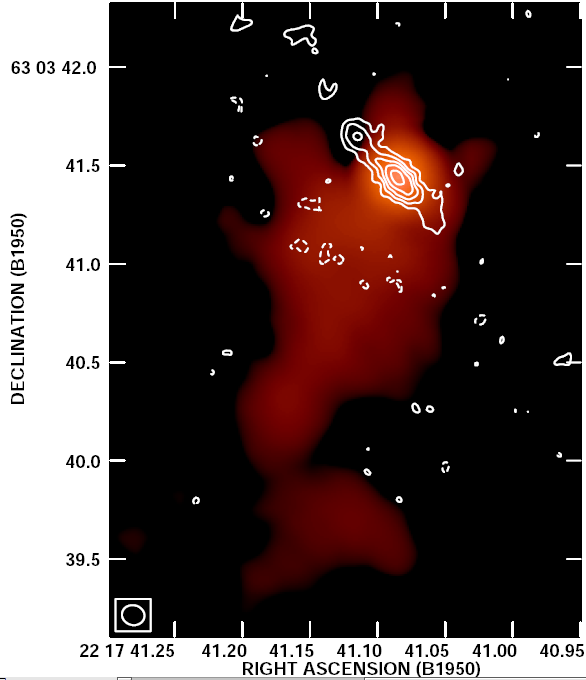 |
An IR K-band speckle
interferometry image of S140 IRS1,
overlaid with MERLIN 5GHz radio
contours.
|
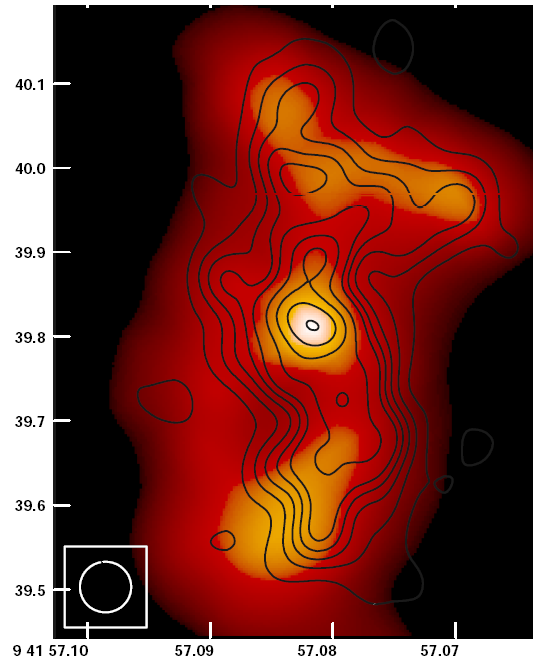 |
The innermost regions of
the symbiotic nova HM Sge (MERLIN
contours overlaid on an HST image).
|
 |
Global VLBI and MERLIN observations of the precessing beams of the Galactic radio-jet X-ray binary ("microquasar") system SS433 at 1.6 GHz are shown in the top figure. Focusing on the central parts of the source (bottom) reveals the Equatorial Emission Region (discovered by Paragi et al., 1999, A&A 348, 910), quasi-perpendicular to the normal jets. This region changes with the precession cycle. It is most probably related to an equatorial outflow from the binary system.
|
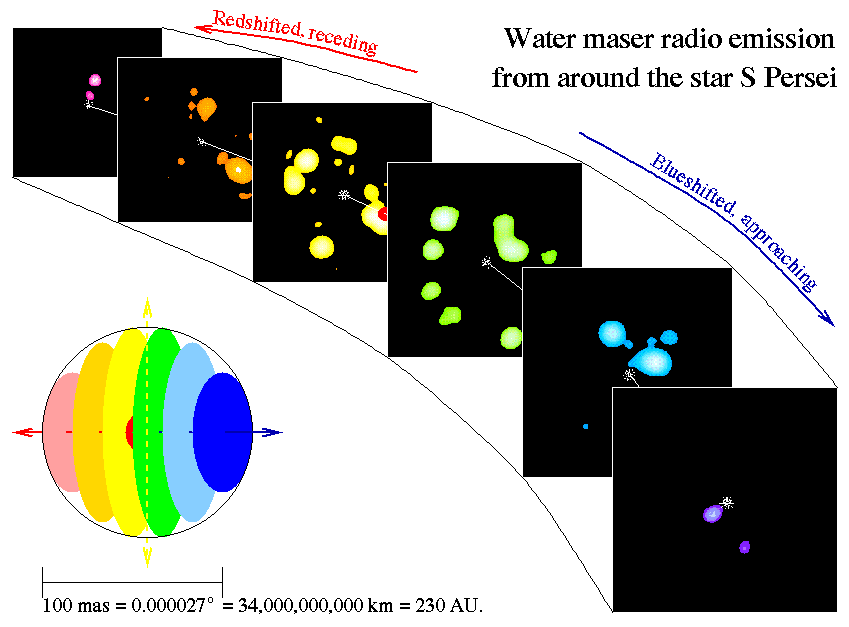 |
Water maser emission from S Per integrated over the whole shell, which covers a velocity extent of over 30 km/s, expanding in all directions from the star. There are bright hotspots surrounded by fainter diffuse emission. In the next figure, the components of this are colour coded: the most blue shifted material is deep blue, through blue and green, yellow material close to the stellar velocity, and then orange - red - purple is increasingly redshifted. The velocity information and milli-arcsecond resolution gives you a 3D image.
|
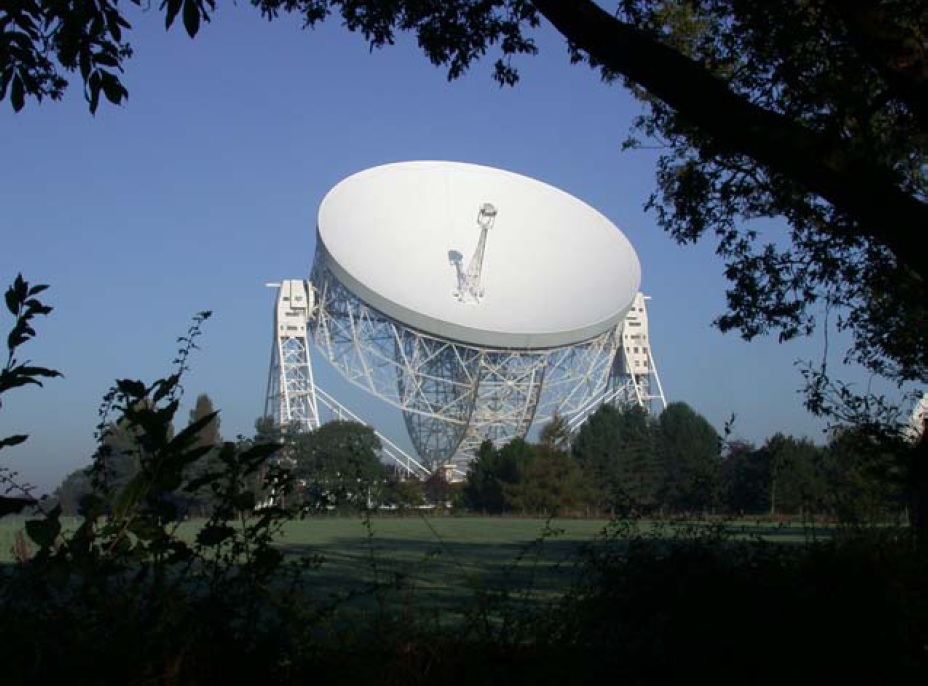 |
The 76-m Lovell telescope at Jodrell Bank Observatory. This telescope is often used as part of MERLIN. |
 |
A composite image of all, apart from the Lovell telescope (above), of the MERLIN telescopes. |
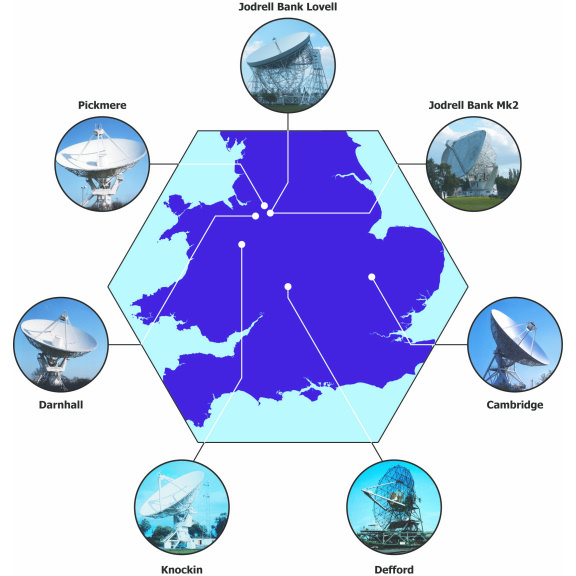 |
MERLIN map and images of telescopes. |
More images of the Lovell telescope and the other telescopes at Jodrell Bank Observatory can be found here
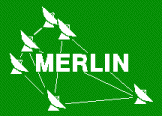 |
MERLIN |
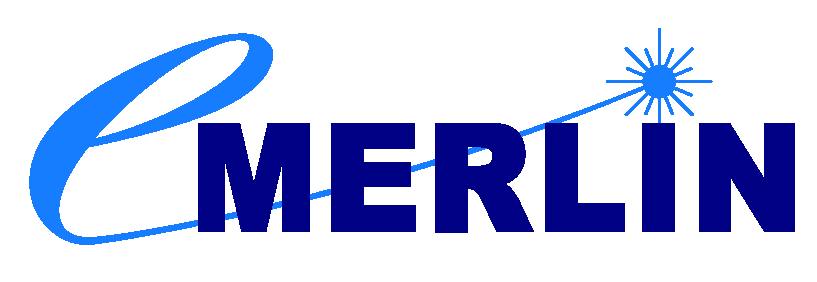 |
eMERLIN |
 |
European VLBI Network (EVN) |
 |
Small JBO & University of Manchester. |
 |
The Particle Physics and Astronomy Research Council (PPARC). |
More radio images of Radio galaxies can be found on the DRAGNs web-page.
Even more EVN and Global VLBI results and images can be found on JIVE's image gallery.